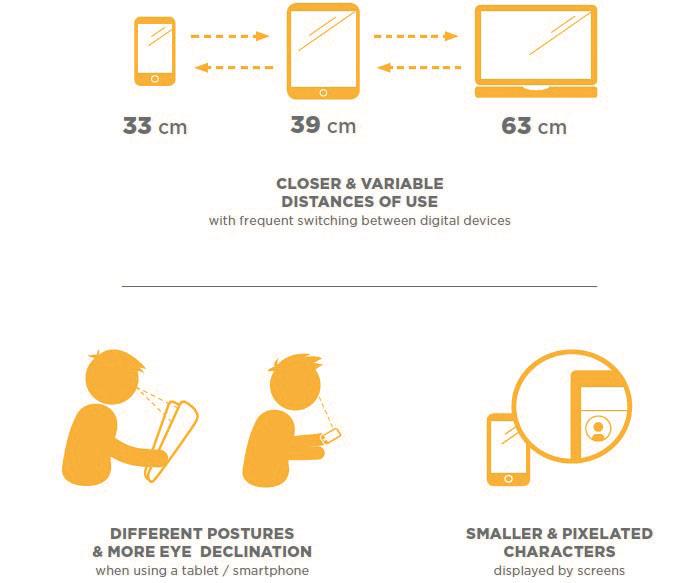
Even readers without Generation Next family members need only to take a ride on a bus or train to see that the visual habits of the younger generation have been very much influenced by their viewing of digital screens, whether they be on smartphones, tablets, computers or game consoles. This has been a point of interest for corrective lens designers, as the way we use our eyes should be reflected in the design of any optical correction.
Are standard single vision lenses out of date?
There have been many efforts to try to quantify visual behavioural changes over recent years. One such study from Essilor1 suggested closer working distances are now being adopted and related to the type of digital device under view. Smaller devices require greater eye declination and also smaller font resolution (figure 1). Postural data (eye-screen distance, eye declination angle, head rotation and roll angle) were measured and analysed with a motion capture system (known as Vicon), which employed eight synchronised infrared cameras that can capture the coordinates (X, Y and Z) of retro-reflective markers in real time. The results confirmed that subjects interacting with digital devices maintain a highly static, even rigid, posture.

Figure 1: Generation Next viewing behaviours1
This does beg the question as to whether the optical centres of standard single vision lenses are no longer appropriate for much of the time. Might an increased reliance of the off-axis lens contribute to the increased levels of visual fatigue reported by digital device users?
Eyezen Start
To address this question, Essilor introduced the Eyezen Start lens. Uniquely, this is a single vision lens that is surfaced in such a way as to offer two distinct reference points; one for distance and one for near (figure 2). They patented this design as Eyezen Dualoptim Technology.
This design gives a reduction of power error and unwanted astigmatism across the whole lens and, importantly, a 60% reduction for near viewing.2,3 Throw in UV protection and the Eyezen Start becomes a very attractive option for the correction of Generation Next, especially where the ECP has confirmed significant digital screen use.
Ordering requires the provision of the distance refraction, monocular PDs and fitting heights. Verification is checked at the distance vision point while the fitting cross needs to be aligned with the pupil centre when a distance target is being viewed.
Eyezen Kids
The first Eyezen lenses, introduced some years ago, were remarkable in offering a range of increased power ‘boosts’ for near viewing. Now called Eyezen Boost, these lenses have four near power options and are popular for pre-presbyopes with a high near vision demand, beginning at age 18.
In the coming autumn, rumour has it that Essilor is looking to launch a new lens aimed specifically at the under-18s; the Eyezen Kids lens. Look out for a review in Optician once details are made available. It seems Generation Next are to be catered for.
- Further information on the Eyezen Start available at www.pointsdevue.com/white-paper/eyezentm-start-new...
References
- Paillé, D., Impact of new digital technologies on posture, Points de Vue, International Review of Ophthalmic Optics, N72, Autumn 2015
- http://essilor-eyezen-start-whitepaper.pagedemo.co
- Rosenfield M, Hue JE, Huang RR & Bababekova Y. The effects of induced oblique astigmatism on symptoms and reading performance while viewing a computer screen. Ophthalmic & Physiological Optics, 2012, 32, 142–148
